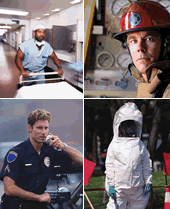EMERGENCY RESPONSE RESOURCES

Emergency Responders
Pre-event preparation, training, and access to readily available information, field assessment, and safety equipment are critical to minimizing consequent deaths, injuries, and illnesses, and to promote overall workforce resilience. Once the event occurs the responders are then placed under a time-urgent, dual-cognitive demand:1) they must attend to the hazards (including attention to self and crew members' safety and health), and 2) they must perform the work necessary to complete a rescue. In the post-event stage (72 hours after the incident), responders may assess potential exposures, conduct rescues, and attempt recovery activities in constantly changing and complex hazardous environments.
Safety Management
Protecting Emergency Responders Safety Management in Disaster and Terrorism Response
NIOSH and RAND produced four reports in a series. The first three reports provide recommendations and the need for research, training and other strategic approaches to help protect emergency responders in terrorist attacks. The fourth report is a technical source for incident commander guidelines for emergency response immediately following large structural collapse events. Each individual report can be accessed using the following links:
- Volume 1 Protecting Emergency Responders: Lessons Learned from Terrorist Attacks
- Volume 2 Protecting Emergency Responders, Volume 2: Community Views of Safety and Health Risks and Personal Protection Needs
- Protecting Emergency Responders, Volume 3: Safety Management in Disaster and Terrorism Response (DHHS (NIOSH) Publication No. 2004-144)
- Personal Protective Equipment Guidelines for Structural Collapse Events, Rand Volume 4
NIOSH Fire Fighter Fatality Investigation and Prevention Program
Each year an average of 105 fire fighters die in the line of duty. To address this continuing national occupational fatality problem, NIOSH conducts independent investigations of fire fighter line of duty deaths. This web page provides access to complete lists of NIOSH investigation reports and other fire fighter safety publications and resources.
NIEHS National Clearinghouse
The National Clearinghouse is funded by the National Institute of Environmental Health Sciences (NIEHS) Worker Education and Training Program (WETP) and is the primary national source for hazardous waste worker curricula, technical reports, and weekly news.
EPA Emergencies Topic Page
Environmental emergencies involving the release, or threatened release, of oil, radioactive materials or hazardous chemicals may potentially affect communities and the surrounding environment. EPA's web site provides information about these activities, links to the key groups involved in contingency planning and response, and provides information on how to report hazardous substance and oil spills.
OSHA Emergency Preparedness and Response Topic Page
OSHA and its State Plan partners help set and implement national safety and health standards for emergency responders. Specialty topics include: Chemical, Biological, Bioterrorism, Radiation, Personal Protective Equipment, Training and Education, and Equipment.
OSHA Best Practices for Hospital-based First Receivers of Victims From Mass Casualty Incidents Involving the Release of Hazardous Substances
Provides practical information to help hospitals address employee protection and training as part of emergency planning for mass casualty incidents involving hazardous substances.
Bloodborne Infectious Disease
NIOSH Bloodborne Infectious Diseases Topic Page
This page has resources and guidelines including engineering controls and work practices to help workers prevent exposure to blood and other body fluids.
First Responders: Protect Your Employees with an Exposure Control Plan
NIOSH Publication No. 2008-115
Provides guidance to develop a comprehensive bloodborne pathogens exposure prevention program that will help protect your employees
Bloodborne Fact Sheets
A series of one page fact sheets on subjects such as using protection when handling sharps, personal protective equipment cut risks, reporting exposure incidents, Hepatitis B vaccination, and decontamination.
Safety and Health Topics Bloodborne Pathogens and Needle stick Prevention
Provides links to OSHA Standards and regulations bloodborne pathogens and needle stick prevention as well as identifying hazards and solutions to exposure.
Personal Protective Equipment
Emergency Response Personal Protective Equipment Page
Personal protective equipment is very important for any emergency responder. There are five main types of PPE that are covered on this page: respirators and protective clothing (selection, proper use, etc.), skin exposures and eye and hearing protection.
Traumatic Incident Stress
Traumatic Incident Stress Topic Page
Provides NIOSH recommendations for workers to reduce the risk of experiencing stress during and after a traumatic event.
Traumatic Incident Stress: Information for Emergency Response Workers
En Español
NIOSH Publication No. 2002-107
Describes the dangers and symptoms of Traumatic Incident Stress, includes resources for coping.
CDC Emergency Preparedness and Response: Coping with a Disaster or Traumatic Event
This web page provides general information for individuals, parents, and families for coping during and after a disaster or traumatic event.
- Page last reviewed: January 30, 2012
- Page last updated: December 2, 2016
- Content source:
- National Institute for Occupational Safety and Health Office of the Director


 ShareCompartir
ShareCompartir